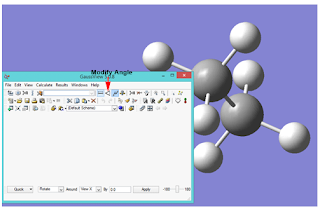"Delving
into the World of Molecular Conformational Analysis with DFT: Unveiling
Structure, Energy Landscapes, and Reactivity"
Introduction:
Understanding the molecular structure and conformational
properties of chemical compounds is essential for unraveling their properties and behavior. Molecular structure,
including bond lengths, angles, and dihedral angles,
plays a crucial role in determining the physical,
chemical, and biological characteristics of molecules. In this article, we will delve
into the significance of molecular structure and conformational analysis and
explore how Density Functional Theory (DFT) can be employed as a powerful computational
tool to investigate these aspects. We will also discuss the application of DFT
in understanding molecular conformations and their influence on reactivity
through case studies.
Determining
Molecular Structure with DFT:
Density Functional Theory (DFT) is a computational method widely used to determine the molecular structure of chemical compounds. It provides
a theoretical framework for predicting various
structural parameters, such as bond lengths, angles, and dihedral angles. DFT employs quantum mechanical principles to calculate the
electronic structure and energy of molecules, enabling researchers to
understand the arrangement of atoms in space.
By solving the Schrödinger
equation for the electronic wave function, DFT allows for accurate predictions of bond
lengths, which are the distances between
atoms connected by a chemical bond. Bond angles,
the angles formed between two adjacent bonds, and dihedral
angles, which describe the rotation between
different molecular fragments, can also be determined using DFT
calculations. These structural parameters are essential for understanding
molecular geometry and its impact on chemical behavior.
Conformational
Analysis and Energy Landscapes:
Conformational analysis involves
studying the different spatial arrangements of a
molecule by exploring its potential energy surface.
A molecule can adopt various conformations due to rotations
around single bonds, resulting in different
energy states and geometric orientations. DFT can aid in the exploration
of energy landscapes by predicting the relative energies of different
conformations.
Through DFT calculations, researchers
can determine the most stable conformer of a
molecule by evaluating the energy differences between
different conformations. This analysis provides insights into the preferred molecular shape and the factors influencing conformational stability. By mapping
the energy landscape, scientists can understand the relationship between molecular structure, conformational preferences,
and energy barriers.
Certainly! Conformational analysis and
energy landscapes can be studied using DFT calculations in in Gaussian and GaussView, a
popular computational chemistry softwares. Let's explore the process;
Molecular
Structure and Initial Conformation:
We begin by defining the molecular structure of interest, which consists of a set of atoms connected by chemical bonds. For example,
let's consider a simple molecule such as ethane
(C2H6). The initial conformation refers to the arrangement of atoms and bond
rotations before any calculations are performed.
3D structure of Ethane
Generating
Conformers:
To explore different conformations, we
introduce rotations around single bonds in the
molecule. In the case of ethane, we can rotate the central carbon-carbon (C-C)
bond. By systematically varying the dihedral angle (τ)
between the two methyl groups (CH3), we generate a series of
conformers.
Optimizing
Conformations using DFT:
Each conformer is subjected to geometry optimization using DFT calculations in
Gaussian. The optimization involves finding the most
energetically favorable arrangement of atoms by minimizing
the total energy of the system. This process takes into account the
positions of all atoms and their electronic
interactions.
Energy
Calculation and Landscape Exploration:
After the geometry optimization, the energy of each conformer is calculated using DFT. The
energy landscape is constructed by plotting the calculated
energy as a function of the dihedral angle (τ).
This landscape provides insights into the relative stabilities of different
conformations.
Role
of DFT in Understanding Molecular Conformations and Reactivity:
DFT plays a vital role in elucidating
the impact of molecular conformations on
reactivity. By predicting energy barriers associated
with molecular transformations, DFT can reveal
the influence of conformational changes on reaction rates and pathways.
Understanding these effects is crucial in fields such as drug design, catalysis, and materials science.
Case studies utilizing DFT have
demonstrated its effectiveness in understanding
the relationship between molecular conformation and
reactivity. For example, in drug design, DFT calculations can shed light
on the preferred conformations of drug molecules, helping optimize their activity and selectivity. In catalysis,
DFT can provide insights into the effect of ligand
conformation on reaction mechanisms and selectivity. By simulating
molecular conformations and reaction pathways, DFT allows researchers to make
informed decisions about experimental design and optimization.
Conclusion:
Molecular structure and conformational
analysis are fundamental aspects of understanding chemical compounds and their
behavior. DFT serves as a powerful computational tool for investigating
molecular structure, energy landscapes, and the impact of conformational
changes on reactivity. By leveraging DFT, researchers can gain valuable
insights into the structural properties of molecules, optimize their
properties, and make informed decisions in various fields of research. The
continued advancement of DFT techniques promises to drive further breakthroughs
in molecular sciences and related disciplines.








No comments:
Post a Comment